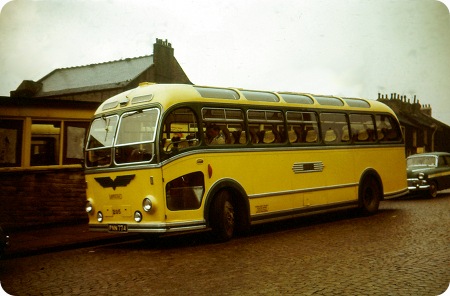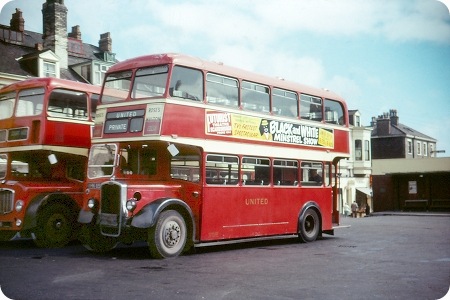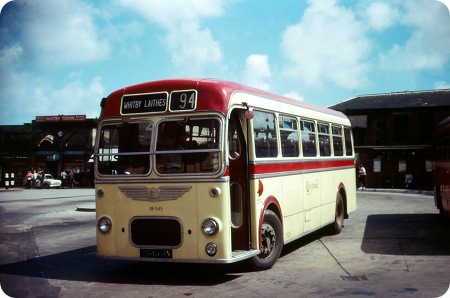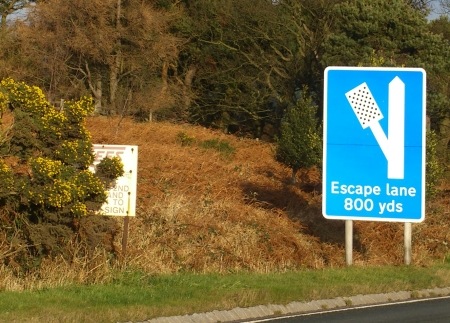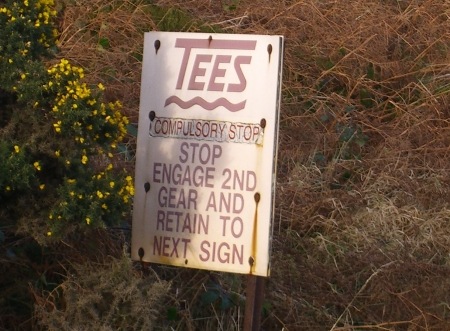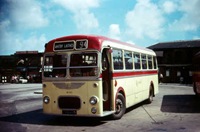Mansfield District – Bristol LS6G – PNN 774 – 205
Mansfield District Traction Company Limited
1954
Bristol LS6G
ECW C39F
This shot is a touch on the yellow side but I think it is worth posting as this vehicle had quite a history having had six owners in its lifetime that I have been able to find out about.
Thanks to the Bristol SU website for the following information.
06/54 - Mansfield District Traction fleet no 205
01/68 - Eastern Counties Omnibus fleet no LS998
02/72 - Gosport & Fareham Omnibus fleet no 33
02/74 - North Downs Rural Transport
07/74 - Ives Weston-on-Trent
02/75 - Kingfisher Weston-on-Trent
02/76 - Out of service I presume it went to scrap at this point although I could be wrong, if I am please leave a comment.
Either way just short of 22 years service was a good innings, just goes to show how well built buses were back then “they don’t build them like that anymore I’m afraid”. It would be interesting to know how many miles were on the clock and whether it still had its original engine even if it had been rebuilt a few times.
To view a list of Bristol vehicle abbreviations click here.
———
The longevity of a PSV of this era was of course determined by the willingness and capability of the operator to prepare the vehicle for its’ CoF examination.
Buses didn’t have a conventional MoT as they now do, instead the bus came new with a 7 year CoF at the expiry of which a recertification was required. The length of the next CoF was determined by the work done to the bus in preparation for the inspection.
Most big operators brought the buses into their central works and overhauled them leading to the issue of a long second ticket after which the cycle was repeated with the tickets getting shorter each time.
The introduction of freedom from defect type MoT’s made this system obsolete
Andrew
———
12/11/11 – 06:17
I was the Managing Director of Kingfisher Coaches Ltd, and feel most embarrassed to confirm that Bristol MW PNN 774 was sent for scrap on my orders. If only I had realised that it was so interesting to so many enthusiasts I would have donated it gladly. It was running perfectly well and had given us outstanding service, but it was almost out of C.O.F. and the upholstery was very shabby. But the reason for quick disposal was the D.O.E. examiner was on my back wanting to inspect it and not being very popular with him he did not approve of any bus or coach over 10 years old.
Sorry folks.
Robert K. Walker
———
12/11/11 – 14:47
In an old British Transport production ‘A Ticket to Ride’ made in 1953, one of the films is about visiting the Peak District, does anyone know if the MW coach shown a few times around Ladybower Reservoir and at the start leaving Grindleford for Hathersage is a Midland General or a Mansfield District vehicle, there are also some other shots of North Western saloons both in Matlock, then passing the winking man rock above Leek and in Buxton, quite a good film.
Roger Broughton
———
13/11/11 – 07:56
One unusual feature about Mansfield District was that they took over an independent in 1958 which gave them three Duple bodied AEC Reliances which had originated with Creamline of Bordon. I believe that these may have been the first Reliances to enter a Tilling fleet. Even though Mansfield District was a majority AEC fleet at the time, they didn’t last that long, I’ve often thought they must have been superior to the LS’s as coaches, but perhaps MDT didn’t like the thought of having third hand vehicles in the fleet!
Chris Barker
———
13/11/11 – 10:52
Shrug off your guilt, Robert, you weren’t to know. Preserved buses, like all memorabilia, often survive as much on pure luck as planning. But don’t go out alone on dark nights for a few weeks!
Chris Hebbron
———
14/11/11 – 07:58
In the early to mid 1970s I used to work for North Downs at weekends, and drove this LS from time to time. I recall that it was quite a nice machine, and tackled the climb on the A25 up to Newlands Corner in fine style. I don’t agree that the Reliance with the AH470 would have been a better coach – the Gardner had much better torque characteristics than the AEC, which permitted higher gearing to offset the limited 1700rpm governed engine speed, and both types had five speed synchromesh gearboxes.
Roger Cox
———
14/11/11 – 17:51
That is a very interesting list Stephen, because I believe that the original routes were simply 100 up for town services and 200 up for ‘country area’ routes. The others were a result of takeovers, 1&7, 2 and 3 were ex Ebor, who used these numbers, 4 was ex Bevan and Barker, who didn’t. Some time after this list, some numbers in the 70’s were added as a result of an agreement with East Midland to co-ordinate services on the Mansfield – Warsop – Shirebrook road, hence 4 disappeared.
One thing I found recently among my possessions was a complete list of destinations from an MDT blind and also a complete list of via points which I achieved (from a Lodekka) by stepping up, turning the handle, stepping down to write, then repeating the process one display at a time! Unfortunately I wasn’t quite sure which routes some of them appertained to although some town services were so short, they didn’t warrant a via point.
Chris Barker
———
15/11/11 – 07:10
Picking up on Roger’s point, here is a widespread belief that Gardner engines didn’t make good coaches, but I wonder if it’s more that both designing them and driving them required a different mindset. Most coaches get into top gear relatively early and then achieve high speed by revving the engine faster than they would in the intermediate gears. But I recently had a ride on the preserved ex-Eastern Scottish Alexander M type Seddon Pennine 7, which was a revelation. The 6HLXB engine is governed at 1850rpm. Top gear (6th) came in at what seemed to be about 62mph, and according to Wikipedia the theoretical top speed of these was 87!
Peter Williamson
———
15/11/11 – 15:59
Although I personally prefer the RELH6L the RELH6G was a superb beast. I have ploughed the motorways as a passenger of many RELH6Gs and they were always man enough for the job.
David Oldfield
———
16/11/11 – 07:27
On the subject of Gardner engines, Cambus/Viscount (now part of Stagecoach) where I worked for a while in the 1990s, had a trio of 1988 vintage Optare bodied Olympians powered by the turbocharged 6LXCT engine. One, E502 LFL, was allocated to Oundle depot for the X65 Peterborough – Northampton service, but when it went into Peterborough for overhaul, it occasionally found its way on to other services in that city before it went back to its proper home. I well recollect a few occasions of driving this bus on the 351 service between Peterborough and Huntingdon, which followed the old dual carriageway A1 (now obliterated by the four lane A1M). This vehicle, which had the Leyland G2 gearbox, could reach an indicated speed of 70mph without great difficulty, though stopping the thing was altogether another matter in which prayer played a part!
Roger Cox
———
16/11/11 – 07:27
I should point out that my comment about MDT’s acquired Reliances was more in relation to their internal appeal rather than their mechanical propensities! However, since the discussion has moved this way, it would seem appropriate to mention that Mansfield’s sister company, Midland General took three RELH6G’s in 1964, registered 1384 -1386 R. I think there has been confusion about their classification ever since which I will attempt to put right. 1385/1386 R had dual purpose seats identical to their DP bus shell MW’s, also a mixture of sliding and hopper ventilators on each side window and semi-automatic transmission, they were officially DP51F. 1384 R, however was a very different machine, it had 49 coach seats, fixed side windows and forced air ventilation and a manual gearbox. Now they may have been delivered all same and this one altered later by MGO, I don’t know, but I was fortunate enough to travel on it a couple of times and boy could it go! The ride was exhilarating to say the least and amazingly quiet too! Does anyone know if there were many other manual box RE’s? In my humble opinion, the ECW coach bodied Bristol RE, when fitted with it’s very ample destination display, electric two piece doors and wrap-around screens was one of the finest vehicles ever to run on British roads, leaving out top link coaching work but for motorway express duties, never bettered even to this day!
Chris Barker
———
16/11/11 – 16:07
All early REs were manual, semi-autos only came in with the Series 2 (allowing for a few at the changeover). The early RELH/ECW (most of which were Gardners) were unassailable for their quiet, smooth ride – a perfect long distance coach.
David Oldfield
———
14/06/12 – 18:22
Roger Broughton asks about the bus in the British Transport Film. It’s Mansfield District 201 (PNN 770) from the same 1954 batch as the above vehicle.
Berisford Jones
I can see a rather good question coming in here.
Quick links to the - Comments Page - Contact Page - Home Page
